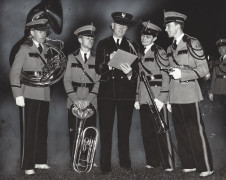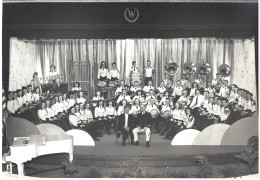George "Red" Bird - Showtime Innovator
George "Red" Bird Bronze Plaque 2025
Massillon Washington High School is believed to be the first in Ohio to have a band play at football games. Dating back to 1914, the band followed a traditional military style, influenced by John Philip Sousa’s marching music. That all changed in 1938 with the arrival of George “Red” Bird as band director. Bird, a graduate of the Ohio State University and the Cincinnati Conservatory of Music, cut his teeth performing with radio and stage bands across the Midwest, experiences he would leverage during his time at Washington High School.
An innovator with a flair for showmanship, Bird introduced a new era of halftime entertainment. He replaced the rigid military format with a more fluid and visually engaging marching style. Bird is credited with inventing the “measured step”—a thirty-inch stride that allowed for exactly six steps to every five yards on a football field. He also introduced music-cued movements, where the band’s visual formations were choreographed to match specific musical phrases, transforming the concept of a football halftime into a theatrical event. Bird’s innovations signaled the birth of the modern marching band.
Ever the crowd pleaser, Bird incorporated the fresh and energetic sound of swing music into the band’s routine to reflect the popular music of the era. Thus was born the Massillon Tiger Swing Band. To invigorate the on-field show, he flanked the drum major with baton-twirling young women dressed to impress. Bird added extra excitement by placing a student in a real tiger skin costume who followed the band onto the field.
The Massillon Tiger Swing Band was an instant hit. Bird’s own arrangement of “Tiger Rag” became the school’s fight song, and halftime shows evolved into anticipated spectacles. Bird’s innovations not only captivated local crowds but also set a new standard for marching bands across the country. George “Red” Bird was undeniably a pioneer of the modern marching show band who changed the way the game was enjoyed.

George "Red" Bird 1938 |

George "Red" Bird with unidentified Swing Band members 1938–46 |

George "Red" Bird with The Massillon Tiger Swing Band 1938–46 |
For more information about George "Red" Bird and the Massillon Tiger Swing Band, visit the Paul Brown Museum located inside the Massillon Museum, where admission is always free.


